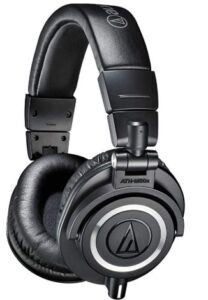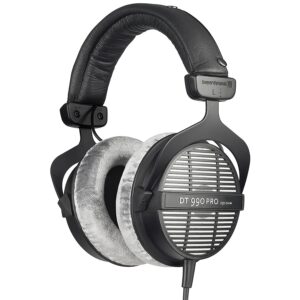If you ask anyone about their headphones, they’ll definitely tell you that they’ve gone through several pairs throughout the different stages of their life. Exchanging a set of headphones for a newer one is always an exciting event. So, how about the purchase of your very first professional headphones?
That’s where things start to get a little bit heated. You’ll be investing a significant sum of money in one device. Therefore, you need to do some thorough research in order to reach the pair most suitable for you.
One of the very first labels you’ll find on different headphones will be either open-back or closed-back. The difference between these two designs is quite simple; however, it leads to a radically different listening experience.
Throughout this article, we’ll walk you through the whole open back vs closed back headphones issue step by step, so that you know which is ultimately best for you.
Contents
Mechanism
So, what is the fundamental difference between closed-back headphones and open-back ones? The whole matter revolves around the exterior design of the earcup.
With closed-back headphones, you’ll find that the ear cup’s outer side is a solid surface; nothing gets in, and nothing gets out. No matter what kind of driver you’ve installed in these headphones, dynamic, electrostatic, or planar, they’ll be covered entirely.
Find Audio-Technica ATH-M50x featured in:
- Audio Technica M40x Vs M50x – Which Is The Better One?
- Headphones For Transcription – Buyer’s Guide
- Headphones Under $150 – Buyer’s Guide
- Headphones for Glasses – Buyer’s Guide
On the other side of the spectrum, you’ll find that open-back headphones come with perforated external surfaces. They can come in several shapes such as grills, vents, holes, or even a honeycomb appearance; the main idea is that air and sound are both allowed in and out freely and without restraint.
Find Beyerdynamic DT 990 PRO featured in:
Echo
As we’ve mentioned before, the difference is straightforward, but the results are accumulative. The first immediate result is the echo that happens with closed-back headphones.
You see, when you choose closed-back headphones, you’re selecting a closed chamber design. The sound coming out of the headphones has nowhere to go except your ear canal. Therefore, this confined space has to create some echo at some point, which can intrude on your listening experience.
On the other hand, open-back headphones don’t suffer from such a problem, as constant air circulation eliminates such a possibility.
Sound Quality
How does all of that add up in terms of sound quality, and what you will receive from each variety of headphones?
Let’s start with closed-back headphones. If you want to sum up this type of headphones, you’ll have to say noise isolation. As a matter of fact, closed-back headphones are one of the main factors that contribute to passive noise cancellation or noise isolation.
The solid exterior physically prevents soundwaves and air from going in or out, which means that you’ll be absolutely secluded from the world around you. This type of noise isolation can remove up to 30 dB of unwanted sound, especially sudden ones such as voices.
Moreover, you’ll feel like the voice is inside your brain, not coming from an external source. To add, the closed-chamber design, which we’ve spoken about earlier, emphasizes low frequencies and bass, leading to a generally heavier deeper output.
On the contrary, open-back headphones are all about warm natural tones. The constant circulation of air and diffusion of sound waves in and out allows you to feel as if what you’re listening to is blending with everything around you. It gives you the feeling of a live concert as if the band is playing right there for you.
Now, it’s all a matter of preference and needs; some prefer to be wholly consumed in their listening experience, while others prefer to retain a sense of their environment.
Uses
The previous point has to lead us to this one: where and when can each type of these headphones be used optimally.
Let us, again, start with the closed-back headphones. They’re an excellent option for noisy surroundings such as when you’re commuting, traveling, or studying. In other words, anywhere where you don’t want the external voices to intrude on you.
This makes them incredibly useful for many individuals such as music producers, DJs, students, band musicians, such as drummers or guitarists, who need to focus on their own output rather than the outside noises.
Music production is sort of a wiggly point, as it’s separated into mixing, mastering, and recording. Closed-back headphones are great for those who do the recording part, as they’ll be able to focus entirely on their work. Plus, of course, closed-back headphones’ microphone systems tend to be a lot stronger and clearer. So, they offer better inputs.
On the other hand, we have open-back headphones, which provide next to nothing in terms of noise isolation. That might lead a lot of people to think: “why on earth should I invest my money in such a product?.” The reality is that open-back headphones’ sound quality is way superior to anything that can be produced by closed-back ones.
When used in the right environment, open-back headphones will give you a wholesome experience, not only due to their structural design but also their technological one. Actually, they’re mostly known as audiophile-grade headphones due to their great favoritism by audiophiles.
That is because they enjoy all different types of drivers and have these drivers continually vented by the circulating air, so they don’t overheat. They aren’t pressured in any way, allowing them to produce consistent exemplary output. Consequently, they’re great preferences for people who work with mixing or mastering in music production.
Comfort
We’ve just mentioned that the air circulation prevents heat build-up from happening around the drivers, but that’s not the whole case. With open-back headphones, the air circulation will prevent heat and pressure from building up anywhere, including your own ears. Therefore, you won’t find yourself bothered or heated, no matter how long you choose to use them.
Contrarily, closed-back headphones totally neglect such a concept, leaving you to the necessity of frequent breaks in order to relieve the build-up of heat and pressure around your ears.
Sweat
The result of such a build-up is sweaty ears, which can not just disturb you, but perhaps even cause some serious infections if neglected for long periods. Additionally, it can also, over time, ruin your drivers as, without air movement, the sweat particles might accumulate within them. Open-back headphones, of course, easily dodged a bullet with their design in that relation.
Weight
Weight is also one of the most detrimental factors that affect your overall comfort level with your headphones. Closed-back headphones need a lot of material in order to achieve that sealed design. The robust exterior shell is typically made of plastic or steel, which usually weighs a lot. By the effect of gravity, it will unquestionably, bring your head down over time.
Additionally, the excessive padding around the ears helps with overheating this entire area and increasing the weight that you’ll have to support.
On the other hand, open-back headphones, with their perforated exterior and minimal padding, come with a lightweight label that is sure to persuade you to buy them strongly.
Price
All of the factors that we’ve discussed previously will lead us to the issue of the price tag of each of these headphones.
Overall, open-back headphones are more expensive than closed-back ones. That’s not only due to the extensive thought that goes into their design but also their technological advancement.
In terms of their availability and variety on the market, though, they’re unfortunately lacking. You will have to do some digging around in order to reach a model that you like.
Closed-back headphones, however, flood the market with their variety. You’ll find the price range to be incredibly diverse, which makes the process of purchasing a pair a lot easier.
Final Thoughts
In conclusion, each one of these headphones comes with a plethora of advantages and disadvantages. The key to knowing which one would suit you better is knowing yourself. Your own needs, wants, budget, and the circumstances in which you’ll be utilizing these headphones are all variables to your equation.
The optimal choice is to try to purchase one of each so that you’ll have the freedom to pair your headphones with what will be going on during your day if that’s financially possible. Nevertheless, if such an investment will be a financial burden, then the majority wins.
If you spend most of your time commuting or studying and your main objective is to lockout external sounds, then closed-back headphones will be your best friend.
However, if you’re someone who works from home and enjoys the quiet environment around them while valuing exceptional sound quality, then open-back headphones will be the perfect choice for you.


